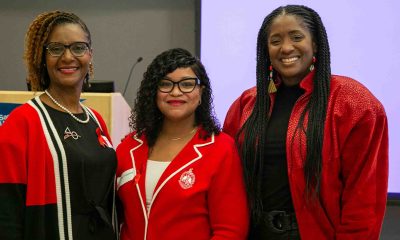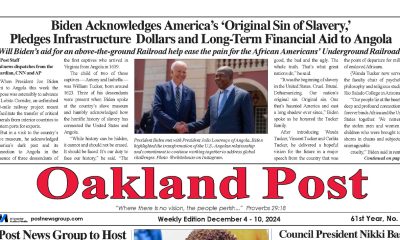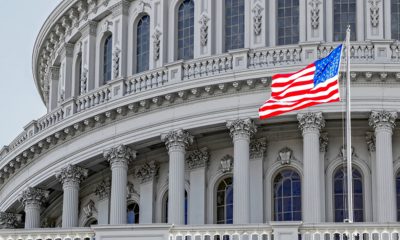Environment
Energy Savings: Ways to Save This Summer

By Genoa Barrow | California Black Media
Whether or not temperatures will hit triple digits remains to be seen, but Pacific Gas & Electric (PG&E) has tips to keep customers from getting burned on their bills this summer.
The energy company’s website offers lots of warm weather advice, from using a microwave or an outside grill to cook on hot days instead of cooking in the oven to painting walls in light colors to keep rooms cooler. Small things can lead to significant savings, says Allen Fernandez Smith, PG&E’s Manager of Low-Income Programs and Strategies.
“One of the easy ways to save is setting your thermostat,” Fernandez Smith shared.
“Set the temperature on your thermostat a little bit higher so that your air conditioner turns on maybe a degree or two higher than you’re used to, which still may be comfortable for many folks, they may not even notice it, but it can save money,” he continued.
Washing in cold water instead of hot saves customers up to $40 a year, according to PG&E. Using and switching off power strips can save someone up to $75 a year. Manyappliances and devices draw power even when they’re off, so unplugging coffee makers, cell phone chargers,televisions and entertainment systems helps to avoid unnecessary energy uses. PG&E’s website also has tips for parents with children who will be out of school for the summer using more energy than a household would typically see during the week in order to entertain themselves.
California residents can also avoid higher bills by going to cooling centers that open during the summer when temperatures soar. These centers can be used as an alternative to leaving on air conditioning and fans for extended periods of hot weather. PG&E helps fund suchcenters throughout the state.
“That’s a really great thing that’s being used by many families,” Fernandez Smith said, adding that some centers even offer transportation.
The summer savings tips are part of the energy company’s overall effort to help customers. The company also offers different programs to those who may need extra assistance in paying their bills every month. “We’re here to support all of our customers,” Fernandez Smith said.
“We understand that California is a very diverse state and our customers are also very diverse with many different needs and we want to make sure we’re meeting their needs by providing safe, reliable, affordable clean energy,” he continued.
PG&E has a Communities of Color Initiative and works with a network of community-based organizations and faith-based leaders to spread the word and encourage customers who are eligible to apply for the saving programs.
“It’s a two-way street. Part of it is us being able to provide these organizations and leaders with tools and tips so that they can share with their communities, but also it’s for us to get feedback from them,” Fernandez Smith said.
“Are the messages that we’re putting out there, can people understand them? Are they in the languages that are necessary? Are they (done) in a way where they’re culturally relevant to these communities? We want to hear directly from our customers on how we can better serve them,“ Fernandez Smith shared.
Online resources include www.pge.com/saveenergymoney and www.pge.com/coolingcenters.
Alameda County
Electric UPS Delivery Fleet Coming to Oakland, Richmond, and SF
The project will replace the current Class 6 UPS delivery trucks with ZE battery electric vehicles. It will also install chargers at the Bay Area logistics centers. In total, 40 vehicles and chargers are coming to the facility near Oakland, another 10 in San Francisco and 10 more in Richmond.

The Richmond Standard
A total of 60 UPS delivery trucks serving logistics centers in Oakland, Richmond, and San Francisco will be replaced with electric versions as part of a partnership between the delivery business and the Port of Oakland.
The Port will use a newly announced award of $10.5 million in Environmental Protection Agency grants and $5 million from UPS to advance the fleet conversion.
The project will replace Class 6 UPS delivery trucks with ZE battery electric vehicles. It will also install chargers at the Bay Area logistics centers. In total, 40 vehicles and chargers are coming to the facility near Oakland, another 10 in San Francisco, and 10 more in Richmond.
The project will feature opportunities for green career pathways through workforce development and training.
“The Port of Oakland is grateful for additional investments to transition freight equipment and infrastructure to zero emissions,” Colleen Liang, the Port’s director of environmental programs and planning.
Richmond Mayor Eduardo Martinez said the “bold investment” will curb pollution, protect public health and provide good-paying green jobs.
“The City of Richmond welcomes this bold EPA investment in zero-emission heavy-duty vehicles,” Martinez said in a statement.
For more information, see the 2024 EPA Clean Heavy-Duty Vehicle Grant Project.
California Black Media
Gov. Newsom Goes to Washington to Advocate for California Priorities
Gov. Gavin Newsom traveled to Washington, D.C., for meetings with senior Biden-Harris Administration officials and members of California’s congressional delegation. During the week, he pushed for increased resources to improve public safety and quality of life in California.

By Bo Tefu, California Black Media
Gov. Gavin Newsom traveled to Washington, D.C., for meetings with senior Biden-Harris Administration officials and members of California’s congressional delegation.
During the week, he pushed for increased resources to improve public safety and quality of life in California.
“California is continuing our work to secure additional tools and resources to improve access to health care, clean air and water, and secure critical funding to support communities recovering from disasters,” said Newsom.
At the White House, Newsom met with President Joe Biden and key officials, advocating for disaster relief funding, healthcare expansion, and environmental protection. He also engaged in discussions with senior Biden-Harris officials, including Interior Secretary Deb Haaland, to address water quality improvements and the San Luis Dam project, which will support water supplies for two million Californians.
“Building on our strong partnership with the Biden-Harris Administration, California is working closely with the White House over the next two months to deliver the critical protections and resources our communities need,” Newsom said.
On Capitol Hill, Newsom met with California Senators Alex Padilla and Adam Schiff, along with other Congressional leaders, to emphasize the need to approve pending disaster funding, healthcare programs, and environmental protections. He also previewed California’s upcoming special session to proactively address potential federal challenges when President-elect Donald Trump is sworn into office.
Newsom’s discussions also focused on securing Medicaid waivers from the Center for Medicare & Medicaid Services (CMS) to enhance behavioral health services and reduce homelessness. The state seeks approval for the BH-CONNECT waiver, which would address behavioral health and homelessness, and the MCO Tax Waiver, which would provide over $20 billion for Medi-Cal to improve healthcare access.
Additionally, California is pushing for Clean Air Act waivers from the U.S. Environmental Protection Agency (EPA), which are crucial for enforcing air quality regulations. These measures are projected to prevent 11,000 premature deaths and provide $116 billion in health benefits over the next three decades, according to the Governor’s office.
Activism
LIVE! — TOWN HALL ON RACISM AND ITS IMPACT — THURS. 11.14.24 5PM PST
Join us for a LIVE Virtual Town Hall on the Impact of Racism hosted by Post News Group Journalist Carla Thomas and featuring Oakland, CA NAACP President Cynthia Adams & other Special Guests.
Thursday, November 14, 2024, 5 p.m. – 6:30 p.m. PST


Join us for a LIVE Virtual Town Hall on the Impact of Racism hosted by Post News Group Journalist Carla Thomas and featuring Oakland, CA NAACP President Cynthia Adams & other Special Guests.
Thursday, November 14, 2024
5 p.m. – 6:30 p.m. PST
Discussion Topics:
• Since the pandemic, what battles have the NAACP fought nationally, and how have they impacted us locally?
• What trends are you seeing concerning Racism? Is it more covert or overt?
• What are the top 5 issues resulting from racism in our communities?
• How do racial and other types of discrimination impact local communities?
• What are the most effective ways our community can combat racism and hate?
Your questions and comments will be shared LIVE with the moderators and viewers during the broadcast.
STREAMED LIVE!
FACEBOOK: facebook.com/PostNewsGroup
YOUTUBE: youtube.com/blackpressusatv
X: twitter.com/blackpressusa
-

 Activism4 weeks ago
Activism4 weeks agoOakland Post: Week of November 27 – December 3, 2024
-

 Activism2 weeks ago
Activism2 weeks agoButler, Lee Celebrate Passage of Bill to Honor Congresswoman Shirley Chisholm with Congressional Gold Medal
-

 Activism2 weeks ago
Activism2 weeks agoPost News Group to Host Second Town Hall on Racism, Hate Crimes
-

 Activism2 weeks ago
Activism2 weeks agoDelta Sigma Theta Alumnae Chapters Host World AIDS Day Event
-

 Business2 weeks ago
Business2 weeks agoLandlords Are Using AI to Raise Rents — And California Cities Are Leading the Pushback
-

 Activism3 weeks ago
Activism3 weeks agoOakland Post: Week of December 4 – 10, 2024
-

 Arts and Culture1 week ago
Arts and Culture1 week agoPromise Marks Performs Songs of Etta James in One-Woman Show, “A Sunday Kind of Love” at the Black Repertory Theater in Berkeley
-

 Activism2 weeks ago
Activism2 weeks agoOakland Post: Week of December 11 – 17, 2024






























































